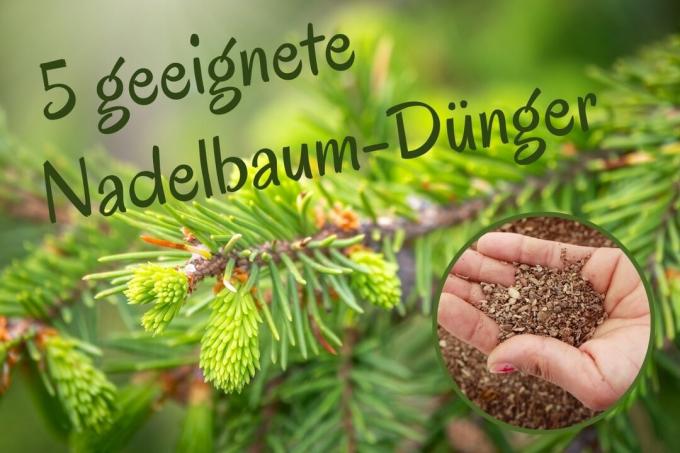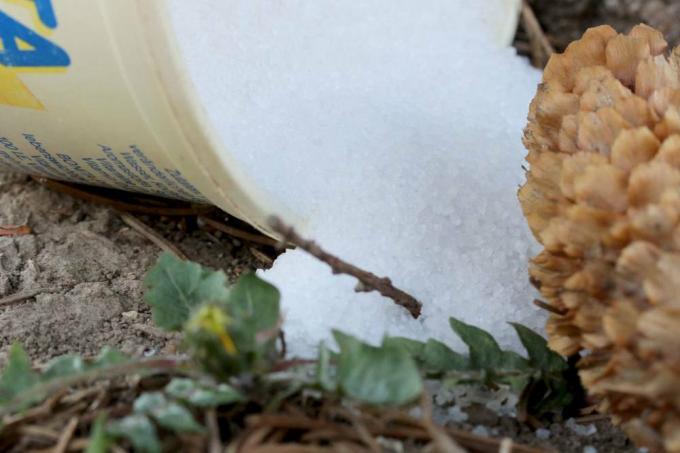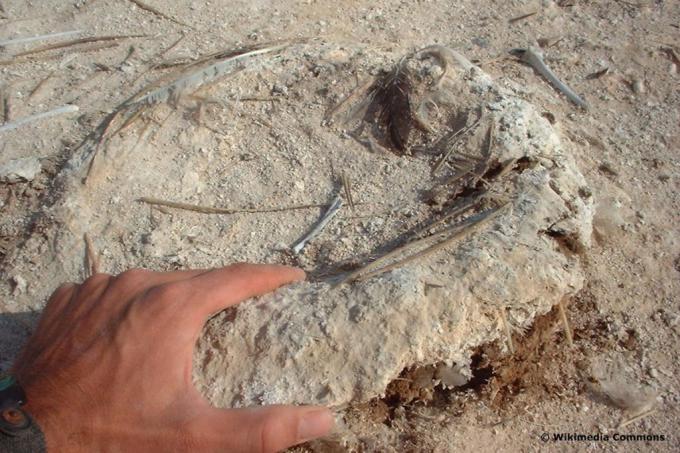
table of contents
- Fir Fertilizer: Necessary Ingredients
- 5 high quality fertilizers
- Epsom salt
- Ready-mixed pine fertilizer
- guano
- Horn shavings
- Potash magnesia
- frequently asked Questions
Like all other woody plants, conifers depend on an optimal supply of nutrients. There are various pine fertilizers for the plants, which are presented to you in this guide.
In a nutshell
- Compared to deciduous trees, conifers require significantly more magnesium, iron and nitrogen
- suitable conifer fertilizers contain less phosphorus and potassium
- Magnesium and iron ensure the optimal supply of nutrients to the needles
- Good fertilizers for conifers are recognizable by their rich needle color
- Magnesium fertilizers are an excellent booster for the trees
Fir Fertilizer: Necessary Ingredients
If you want to keep conifers, you have to pay special attention to the fertilizer used. Conventional fertilizers with a classic NPK composition are often not sufficient for firs, pines or larches because they depend on a different nutrient composition. A nutritional deficiency can mainly be recognized by the following symptoms:
- brown discolored needles
- yellow discolored needles
- weak growth

In this case, the conifers do not have the right nutrients available. If you fertilize incorrectly, there can be a nutrient deficiency, especially over the summer. Fertilizers that provide higher amounts of nitrogen and the important magnesium are particularly suitable. Magnesium supports photosynthesis and is less common in soils that are preferred by conifers, such as sandy soil. That is why coniferous fertilizers specialize in a good supply of magnesium, while phosphorus and potassium play a subordinate role. They should also contain the following nutrients in order to maintain the vitality of the plants in the long term:
- iron
- sulfur
Note: A start fertilization with ripe compost is recommended if you are either planting bare-root conifers or if the soil conditions are poor for the trees. Sandy or loamy soils make it much easier to grow with a little compost.
5 high quality fertilizers
Now we are going to introduce you to 5 suitable fertilizers for your conifers.
Epsom salt
Epsom salt is an excellent magnesium fertilizer for your conifers. You should not use Epsom salt as the main fertilizer, but as a supporting fertilizer if deficiency symptoms are evident. Epsom salt not only contains a lot of magnesium, but also high amounts of sulfur, which is also important for plants. When fertilizing, you should pay attention to the following points:

- Dosage (maintenance fertilization): 50 to 60 g per m²
- Dosage (magnesium deficiency): 90 to 100 g per m²
- spread around the tree
- work into the earth
- water vigorously
Tip: Mix ten grams of Epsom salt with one liter of water to provide fertilizer directly to the needles. Pour the mixture into a spray bottle and thoroughly spray the needles.
Ready-mixed pine fertilizer
Do not use normal NPK fertilizers and use special mixtures for conifers, which are available in liquid or granular form. They are the perfect fertilizer for the plants, as they offer the already mentioned nutrients in an optimized mixture of high quality. The quality of the mixture is particularly important. Use organic-mineral fertilizers, as primarily mineral variants do not have such a good effect on the plants. Mixtures with compost are ideal for conifers, for example. When choosing, you should take a closer look at the individual amounts of nutrients. Products with the following values are recommended:
- Nitrogen: 8 to 15%
- Magnesium: 5%
- Phosphorus: 2 to 3%
- Potassium: 5 to 6%
- optional: sulfur and iron components
Tip: When fertilizing, be sure to adhere to the dosage information on the fertilizer packaging. If the manufacturer does not provide information about the dosage, give 60 to 120 grams per square meter.
guano
Guano, which is also suitable as an additional fertilizer for conifers, is of high quality. The pine fertilizer offers a good mix of nitrogen and magnesium, which are extremely important for the health of the plants. Guano is already contained in many pine fertilizers, as it improves the effectiveness of the product. You need 40 to 50 percent of the fertilizer per square meter.

Horn shavings
Horn shavings are recommended as a supplement to compost or magnesium fertilizers, as they provide additional nitrogen in high concentrations. Simply work a little of the horn shavings into the soil to support the conifers. 60 to 80 grams per square meter are completely sufficient as a nutrient addition.
Potash magnesia
In order to increase the plants' tolerance to frost, which is particularly recommended for young specimens, you should incorporate a portion of potassium magnesia in autumn. Potash magnesia acts as a pine fertilizer before winter and provides the conifers with sufficient magnesium, sulfur and potassium. 40 to 50 grams of the fertilizer are used per square meter. The fertilizer is also known under the name Patentkali.
Tip: If you cannot find potash magnesia, you can also lime your conifers. Lime has a positive effect on the nutrient supply of the plants, especially if they are not too bad.
frequently asked Questions
In the case of conifers in particular, it is important to examine the soil if there are signs of a magnesium or nutrient deficiency. A soil sample will help you determine if there is a problem. Above all, you should check the pH value, as this can also be the reason for the discoloration of the needles. A pH of 6.0 to 8.0 is ideal.
If granules are used, you usually only need to fertilize once a year. This is possible from the end of February or the beginning of March, after the conifers have already been watered. Magnesium fertilizers such as Epsom salt can be incorporated from the end of February to the end of August depending on when a deficiency symptom can be recognized. Liquid fertilizers are used over the entire period according to the manufacturer's instructions.
While a high-quality coniferous fertilizer is preferably used in the field as granules, specimens in the tub should only be supplied with liquid fertilizer. This is administered via the irrigation water, otherwise salts and burns will form on the substrate. Follow the manufacturer's instructions for dosing in order to avoid over-fertilization.


